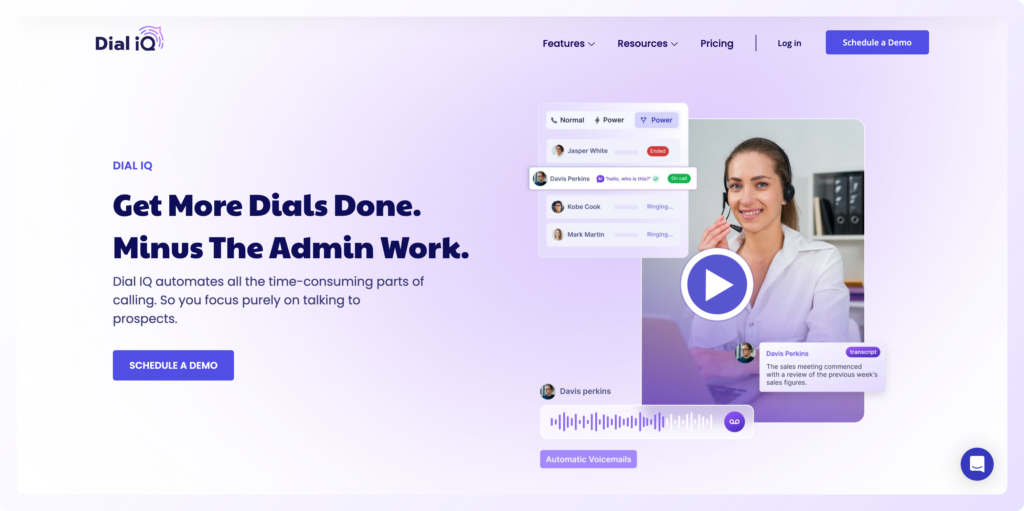Managing incoming calls efficiently is crucial for businesses handling high call volumes because when customers or prospects reach out, they expect a quick and reliable response. But what happens when your reps or agents are unavailable—whether they are tied up with other calls, away from their desk, or out of the office? Customers are left waiting, dealing with long hold times or, worse, unanswered calls.
And when that happens, they don’t just hang up—they often take their business elsewhere. On top of that, your business starts to look disorganized and unreliable, which can damage your reputation in the long run.
This is where call forwarding is a game-changer. It allows you to automatically route incoming calls to the right person or department, regardless of where they are. Whether your team is remote, on the go, or swamped with calls, no customer is left unanswered.
In this blog, we’ll break down exactly what call forwarding is, how it works, and why it’s the ideal solution for businesses looking to manage their call flow more effectively.
What is Call Forwarding?
Call Forwarding redirects incoming phone calls from one number to another. It provides a seamless way to route calls to available agents, mobile devices, or voicemail systems, even when the intended recipient is not available depending on the needs of the business. It ensures that calls are never missed, wherever you and your team members are.
Call forwarding comes in various forms, allowing for different types of redirection based on specific conditions. For example, calls can be automatically forwarded after a certain number of rings, during non-business hours, or when lines are busy. This flexibility makes it an essential tool for businesses looking to maintain consistent communication with their customers.
How does Call Forwarding Work?
Call forwarding operates behind the scenes using a combination of telecommunication technologies to make sure incoming calls reach the right destination, even if the intended recipient is unavailable. Here's a breakdown of how it works:
1. Call Initiation:
When someone calls your business, their service provider—whether it’s a traditional phone line (PSTN) or an internet-based system (VoIP) routes the call to your phone number.
2. Forwarding Logic and Signal Transfer
If you’ve enabled call forwarding, the system checks the rules you’ve set. This could be forwarding all calls during off-hours, redirecting calls when your line is busy, or forwarding only certain calls.
Once a forwarding rule is triggered (e.g., you're unavailable), the system sends a signal to reroute the call to another number. For VoIP systems, the process uses Session Initiation Protocol (SIP). SIP handles the call setup and signaling, ensuring the call can be transferred from the origin to the new destination via IP networks.
3. Routing and Connecting the Call
The system then directs the call to the appropriate destination whether it’s another agent, a mobile device, or voicemail.
Once the call reaches its new destination, the connection is established. If no one picks up, the system might apply fallback rules, such as sending the call to another agent, a voicemail system, or even a call answering service.
Different Call Forwarding Techniques
Call forwarding is not a one-size-fits-all solution. Depending on your business needs, you can choose from several techniques to ensure calls are managed effectively.
1. Always Call Forward
- Use Case: Forward all calls to a designated number, regardless of the time of day or the caller’s identity ensuring no call goes unanswered.
- Example: If you're on vacation, all calls are forwarded to a trusted colleague who can handle them in your absence.
2. Selective Call Forwarding
- Use Case: Forward calls based on specific criteria such as time of day or caller ID.
- Example: Calls from VIP clients are forwarded to a dedicated account manager, while general inquiries go to the main support team.
3. Call Forwarding When Busy
- Use Case: Redirect calls when the primary line is occupied.
- Example: If an agent is on another call, incoming calls are forwarded to another available agent to prevent dropped calls.
4. Call Forwarding When Unanswered
- Use Case: Redirect calls that are not answered after a set number of rings, to ensure no call is left unanswered.
- Example: Calls that are not picked up within 4 rings are forwarded to voicemail or another agent who can follow up.
5. Advanced Call Forwarding
- Use Case: Implement complex routing rules based on various conditions to offer flexibility and customization.
- Example: Calls during business hours are forwarded to the support team, while after-hours calls are routed to an external answering service.
6. Call Forwarding When Unreachable
- Use Case: Redirect calls if the primary contact point is unreachable or turned off.
- Example: If the primary phone is off or experiencing network issues, calls are forwarded to an alternative phone or voicemail.
When Does a Business Require Call Forwarding?
Businesses of all sizes can benefit from call forwarding, especially when managing complex and high-volume communications. Let’s explore some key scenarios where implementing call forwarding becomes essential.
1. Handling After-Hours Calls
When your office closes for the day, customers may still need to reach you for urgent matters. Call forwarding allows these calls to be routed to an answering service, voicemail, or on-call staff members outside of normal business hours, ensuring that important inquiries are handled promptly.
2. Managing High Call Volumes
During busy times, such as sales events or product launches, call volumes can spike, overwhelming your phone lines. Call forwarding helps distribute calls to available agents, departments, or an external call center to ensure no customer is left waiting.
3. Supporting Remote Teams
If your team is spread across multiple locations or working remotely, call forwarding becomes invaluable. It allows you to route incoming calls directly to your employees' mobile phones or home offices, enabling them to stay connected regardless of where they are.
4. Providing 24/7 Customer Support
In today’s fast-paced world, customers expect support around the clock. Call forwarding helps maintain 24/7 availability by routing calls to agents in different time zones or to third-party support services when your primary team isn’t available.
5. Forwarding Calls to Mobile Devices
In industries where employees are frequently on the move, call forwarding ensures that they can still handle important calls. Whether they are traveling between meetings or working in the field, calls can be forwarded to their mobile devices, so they remain accessible.
For instance, a sales representative visiting clients can have their office calls forwarded to their mobile phone, ensuring they never miss a business-critical conversation.
6. Covering Employee Absence
When employees are on leave, sick, or unavailable, call forwarding makes sure that their calls don’t go unanswered. Calls can be forwarded to other team members, ensuring continuity and a consistent customer experience.
Benefits of Call Forwarding
Call forwarding isn’t just about rerouting calls, it’s about ensuring every customer or client interaction is handled efficiently, regardless of the circumstances. There are a number of key benefits that companies can expect when they implement call forwarding.
Never Miss Important Calls
Call forwarding eliminates the risk of missing valuable calls by automatically rerouting calls to an available agent, mobile phone, or voicemail, ensuring no customer inquiry goes unattended. Whether after hours or during high-demand periods, your business remains accessible, which helps build customer trust and ensures important conversations are never missed.
Lower Call Abandonment Rates
If the customers are left waiting for too long or sent to voicemail, they may hang up in frustration—leading to lost business. Call forwarding helps reduce this by directing incoming calls to the next available agent or an alternate number. This quick response helps decrease call abandonment rates and reassures customers that their time is valued.
Reduced Hold Times
Extended hold times frustrate customers and can severely impact their experience. With call forwarding, your team can distribute calls more evenly, preventing any single agent or department from becoming overwhelmed. This leads to shorter hold times, allowing customers to quickly reach the help they need. As a result, your business appears more responsive, reducing the likelihood of customers giving up on a call.
Cost Savings
Manual call routing or investing in multiple receptionists to handle large call volumes can increase operational costs. Call forwarding automates this process, reducing the need for additional staff and infrastructure. By rerouting calls to existing mobile phones or remote teams, businesses can maintain efficiency while lowering overhead costs. The system’s flexibility also reduces the need for expensive hardware, offering a more cost-effective solution.
Improved Customer Experience
Call forwarding ensures that customers reach the right person quickly, whether they’re calling after hours or during a busy period. By reducing hold times, preventing missed calls, and ensuring each call is answered promptly, businesses provide a seamless and positive experience that builds loyalty and enhances satisfaction.
How Can Dial IQ Help You Implement Call Forwarding?
Dial IQ by Klenty is a comprehensive dialing solution that simplifies call management with its VoIP-based call forwarding capabilities.

With Dial IQ, businesses can easily redirect incoming calls to an alternate number, ensuring no customer inquiry goes unanswered. The system also enhances efficiency by identifying returning callers or displaying existing customer information, allowing your team to deliver personalized service instantly.


In addition to call forwarding, Dial IQ provides a range of dialing solutions:
- Multi-mode Dialer Solutions: Utilize Parallel and Power Dialers to efficiently scale your call volume. These modes help maximize productivity by automating and optimizing the dialing process.
- India Dialer: Tailored specifically for calls within India, this dialer enhances local communication and ensures better connectivity with Indian customers.
- Local Presence Dialing: Establish a local presence with customers by using local numbers, improving answer rates and building trust with the customers.
- Integrated CRM Solutions: Seamlessly integrate with your CRM to streamline workflows, manage customer interactions, and sync call data effortlessly.
- Comprehensive Analytics: Access detailed call reports to gain insights into call performance, track key metrics, and refine your communication strategies.
Whether you’re handling high call volumes or aiming to deliver top-tier customer support, Dial IQ equips your team with the tools to operate efficiently and effectively.
Conclusion:
Call forwarding is a simple yet powerful tool that keeps your business responsive and accessible, no matter the circumstances. With benefits like reduced hold times, seamless call routing, and improved customer service, it's essential for any business managing high call volumes.
Book a demo now to witness how you can leverage Dial IQ’s advanced call forwarding features with other powerful tools to provide better service and ensure no call goes unanswered.

